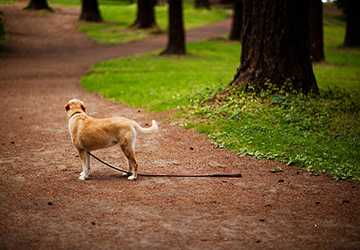What to Do if Your Pet Gets Lost- Immediate Steps
The instant you notice your pet is not where it should be, time becomes of the essence. This guide emphasizes the immediate steps for a lost pet, guides you through what to do if your pet is lost, and aids in finding a lost pet quickly.

First Steps After Discovering Your Pet Is Missing
Begin With a Detailed Search at Home
Initiating a comprehensive search within your home and its immediate vicinity is crucial. Pets are known for their ability to discover and sneak into the most unexpected places.
Alerting Your Community
Informing your community is a pivotal step in what to do if your pet is lost.
● Engage with neighbors: A simple conversation with your neighbors can sometimes lead you directly to your pet.
● Harness the power of social media: Platforms like Facebook and Instagram can be powerful tools for spreading the word.
● Distribute informative flyers: Post a recent photo and description of your pet in key community spots to effectively alert your community.
Embrace Technology and Local Resources
In today's digital age, various tools and local resources can be beneficial in finding a lost pet quickly.
● Online platforms for lost pets: Websites dedicated to reuniting lost pets with their owners can extend the reach of your search.
● Notify animal shelters and vet clinics: Making local shelters and vets aware can help someone recognize your pet.
Proactive Measures to Mitigate Future Risks
While the current focus is on what to do if your pet is lost, taking steps to prevent such incidents is equally essential.
● Consider microchipping: A microchip can serve as a permanent ID for your pet, ensuring they can always be linked back to you.
● Maintain up-to-date photographs: These are invaluable for flyers and online posts if your pet ever goes missing again.
● Secure your home environment: Minimize the chances of your pet wandering off by securing potential escape routes.
Maintain Optimism and Broaden Your Search Efforts
The journey to finding a lost pet quickly requires patience and optimism. It is essential to keep the faith and continue your search efforts over time.
● Expand the search perimeter: Gradually extend your search to areas beyond your immediate neighborhood.
● Stay in touch with local shelters: Regular check-ins with shelters and vets are crucial in finding a lost pet quickly.
Diving Deeper into the Quest for Your Missing Pet
After you have taken the first steps and spread the word within your community, it is time to explore deeper strategies to enhance your chances of reunion with your pet.

Broadening the Reach Through Community Channels
Initiate contact with community broadcasting outlets such as local radio, newspapers, and television channels. Many of these platforms may offer to broadcast lost pet announcements at no cost or feature segments dedicated to community notices, which can significantly amplify the visibility of your lost pet.
Harnessing the Power of Familiar Scents
Given the remarkable olfactory abilities of most pets, deploying scent-based strategies can be incredibly effective. Positioning personal items imbued with familiar smells around your residence can act as a beacon for your pet. Consider using your own clothing, bedding, or blankets to create these scent trails.
Exploring Unconventional Hideouts
There are instances where pets find themselves trapped or hidden in locations where their presence goes unnoticed. Inspect all such potential hideouts in and around your area, including unused buildings, construction zones, or beneath porches. Notify local workers and construction teams to be vigilant for signs of your pet.
Forging Connections with Animal Advocates
Establishing ties with local animal rescue organizations and specific breed rescue groups can open new avenues in your search. These entities possess vast networks and are seasoned in the nuances of pet recovery, potentially offering extra hands and resources to aid your search efforts.
Active Engagement in Digital Spaces
Beyond social media posts, immerse yourself in online communities and forums dedicated to lost and found pets. These platforms can provide specialized support and increase the chances of locating your pet, especially within your local region or among breed-specific groups.
Enlisting Professional Assistance
When your pet remains missing for an extended period, consider the professional aid of pet detectives or scent-tracking canine units. These experts employ various methods, including dogs trained in scent detection, to assist in locating missing pets.
Continual Communication with Your Network
Keeping your community updated is crucial in keeping your search active. Regularly share updates, sightings, and new photographs across your networks to ensure your pet remains a priority in the community's collective consciousness.
Sustaining Hope and Readiness
Facing the emotional strain of a lost pet demands resilience and ongoing effort. Being prepared for their eventual return is vital.
Anticipating the Joyful Reunion
Develop a comprehensive plan for your pet's return, covering necessary veterinary assessments and updating any registration details or microchip information. Maintain a positive outlook and persist in your search efforts, drawing strength from stories of pets reunited with their families after extended periods.
Insights Gained from the Experience
Upon your pet's safe return, take time to assess how the escape occurred and what can be done to prevent future incidents. This could involve additional training, enhancing the security of your home, or ensuring that all identification tags and microchips are up to date with the latest contact information.
Conclusion
Realizing your pet is missing is an anxious experience, but equipping yourself with knowledge on what to do if your pet is lost and following through with the immediate steps for a lost pet can significantly increase your chances of a happy reunion. By taking a structured approach to your search, staying hopeful, and utilizing both digital and local resources, you enhance the likelihood of finding your lost pet quickly. It's a daunting task, but many pets return to loving homes with determination and the right strategies.







